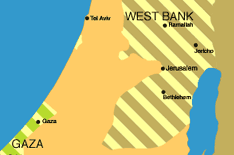A Region at War:
In the early 1950s, a change of regime in Egypt opened the door to peace with Israel, but this opportunity would soon be lost in the wake of two events that would mar Israeli-Egyptian politics for decades. In 1954, an Israeli spy ring was caught trying to bomb U.S. and British institutions in Egypt with the intent of provoking animosity between Egypt and the Western powers. The resulting scandal and attempt to shift the blame among various Israeli officials became a complex, prolonged, and embarrassing fiasco reaching the highest levels of Israeli politics.
Growing suspicions between Egypt and Israel led to an arms buildup and, increasingly, border skirmishes. These became open hostilities upon Egypt’s nationalization of the Suez Canal, closing it to Israeli shipping, in 1956. In response, Israel, France, and Britain colluded in a plan involving an Israeli invasion of the Sinai Peninsula; Britain and France hoped to re-establish European control of the Suez. In autumn of that year, after Israel quickly conquered Sinai, the U.S. became furious with the three countries and put a stop to the plan. Israeli forces retained possession of Sinai for some time, but the crisis left Egypt in control of the Canal and European influence in the Middle East greatly diminished.
In the 1960s, Israeli efforts to marshal the region’s scarce water resources became a pivotal issue, along with the origins of the Palestine Liberation Organization (PLO). In 1964, as Israel took concrete steps to utilize water from the Sea of Galilee for irrigation, Arab states gathered in two summits to lay the foundation for the PLO, an organization established to encourage terror attacks and eventually eliminate the state of Israel. Following these meetings, hostilities grew between Syria and Israel as Syria attempted to divert the water from Israel’s program; Israel responded with attacks on Syrian equipment. At around this time, Egypt’s president made bellicose statements about a coming war with Israel, echoed by the PLO.
Though many believe that neither Israel nor the Arab states truly wanted war, tensions escalated nonetheless. Arab states made reciprocal defense agreements; Egypt dismissed U.N. peacekeeping troops from Sinai and closed the Straits of Tiran to Israeli shipping; and Israel and its hostile neighbors generally mobilized for battle, with Egyptian, Syrian, and Jordanian troops massed near Israel’s southern, northern, and eastern borders. With no sign that opposing states — particularly Egypt — would back down, Israel struck preemptively on June 5, 1967. Six days of battle dominated by Israel followed, ending in a cease-fire that extended its territory over Sinai, the West Bank and Gaza strip, and into the Golan Heights of Syria; the decisive event came to be known as the “Six-Day War.” Soon after, U.N. resolution 242 passed, calling for rollback of Israeli borders to their pre-war state, though Israel held the territory.
The success of this campaign had far-reaching effects: Israel emerged more confident, and used the Occupied Territories to strengthen its bargaining position among its neighbors and as land for Israeli settlement. Arab resentment on behalf of those affected by Israel’s advances grew, as many more Arabs had fallen under Israeli authority, and others fled in another wave of Palestinian refugees. Also, many Palestinians now doubted the ability of the Arab states to effectively oppose Israel; in contrast, the PLO — of which Yasser Arafat assumed leadership in 1969 — would develop effective armed guerrilla and terror operations against Israel, independent of neighboring Arab states.
In coming years, regime change in Egypt once again suggested possibilities for peace as Egypt’s president, Anwar Sadat, made repeated efforts to regain territory in Sinai by diplomatic means. But in 1973, following Israeli rejections of these advances, Egypt and Syria launched a surprise attack on the Jewish Day of Atonement, Yom Kippur. This war, known as the Ramadan War or the Yom Kippur War, saw initial territorial gains by Egypt and Syria; these were eventually reversed, leaving Israel with still more land reaching deeper into both Egypt and Syria. A key feature of the war was involvement of the United States and the Soviet Union to an unprecedented degree — both as suppliers to both sides, and in diplomatic efforts toward resolution. U.S. support of Israel led the latter to become increasingly dependent upon America, and provoked Saudi Arabia to lead an oil embargo with a major impact on the U.S. and world economies.
- Previous: 1914 – 1949
- Next: 1973 – 1993



